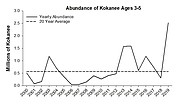Pend Oreille kokanee numbers leap into the record books
Lake Pend Oreille may be in the flush of a bonus kokanee fishery.
Anglers who have started chasing the landlocked salmon, one of the lake’s prize fisheries and the foundation of Pend Oreille’s world-class rainbow fishery, have so far met with success.
Some of it unforeseen.
“One of our guys has been fishing in Ellisport Bay and they knocked them dead the other night,” said Tom Anderson of North 40 Outfitters in Ponderay. “I’ve also heard some good reports out of Garfield and the odd report of good fishing at the Monarchs.”
Idaho Fish and Game estimated the LPO kokanee population last fall at more than 2 1/2 million adults — the highest number in more than 25 years.
Usually when there are a lot of kokanee, the fish tend to be smaller because they have to compete for food.
When populations skyrocket, anglers might catch mature fall fish that range in size between 8 and 10 inches, but there is a bonus in this year’s big numbers:
“The fish mature more slowly and we get four-year-old fish,” said Matt Corsi, the lake’s fishery manager.
And because they take four years to mature, the fish tend to be bigger in the fall despite a sizable population.
So far this spring, the fish haven’t been super big, but Fish and Game expects that by the end of summer the landlocked sockeye salmon known as silvers and blueback could reach 11 or 12 inches.
State fishery biologist Sean Wilson agrees that large kokanee populations would normally have biologists predicting smaller-than-average adults, however a ‘bonus class’ of four-year-old fish is this year boosting the fishery in both in numbers and in size, Wilson said.
As of last fall, some of the three-year-old fish hadn’t matured, and although they were big enough to catch, they are still out there and growing, Wilson said.
“They will only be bigger this year,” he said.
Glenn Lefebvre of Sandpoint was among anglers trolling for kokanee in the southern end of Pend Oreille and he picked up his limit in a few hours.
“I put in at 6:30 and was out by 10,” Lefebvre said. “It was a perfect morning for kokanee.”
Lefebvre found the best fishing from the lake’s south end to Garfield Bay and on the east side along the Monarch Mountains.
“Ours averaged 9 inches and the biggest was 11 inches,” Lefebvre said. “They will pick up some more length and weight by August.”
Kokanee are the keystone of the Lake Pend Oreille fisheries, Kiira Siitari, Fish and Game spokesperson said.
“Not only are they a popular sport fish in their own right, but they also provide the necessary forage to grow world-class rainbow trout, sustain native bull trout and feed a myriad of other predators,” Siitari said.
Biologists believe aggressive predator fish suppression over more than a decade, coupled with low numbers of freshwater Mysis shrimp, are creating perfect conditions for abundant kokanee,.
But it’s not just the adult fish that are pushing the numbers sky high, Siitari said.
“Biologists have documented a boom in juvenile kokanee as well as adults,” she said.
Since 2012, the number of juvenile kokanee between the ages of one and three years old has exceeded the 20-year average, totaling between six to 12 million fish annually, according to IDFG.
Young fish are too small for anglers to catch but they make up a staple food base for fish like the lake’s world-class rainbow trout.
Researchers have linked fast rainbow trout growth rates to high juvenile kokanee numbers.
Last year Lefebvre caught kokanee in the 7-inch range, he said. This spring, he and his angling party used pink hootchies to catch their limit.





